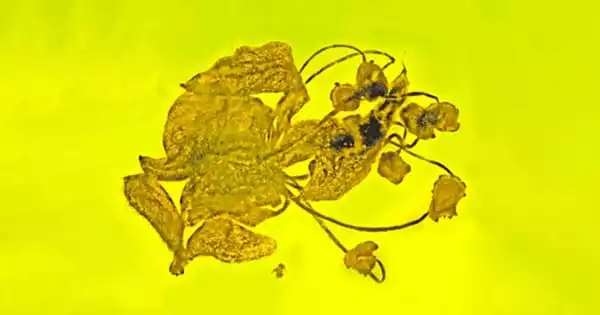The flowers of Salpinganthium hispaniolanum were discovered in several amber lumps recovered from an amber mine in the Dominican Republic’s mountains. The new species represents a new genus and is a member of the pea family Fabaceae.
Researchers from Oregon State University have described a new legume tree derived from flowers embedded in several lumps of amber recovered deep within an amber mine in the Dominican Republic’s mountains.
George Poinar Jr. and Kenton Chambers of OSU identified the 20- to 30-million-year-old flowers as Salpinganthium hispaniolanum, a new genus and species in the Fabaceae family. The Fabaceae or Leguminosae family of flowering plants, also known as the legume, pea, or bean family, is a large and agriculturally important flowering plant family. It includes trees, shrubs, and perennial or annual herbaceous plants that can be identified by their fruit (legume) and compound, stipulate leaves. Many legumes have distinctive flowers and fruits. With approximately 765 genera and nearly 20,000 known species, the family is widely distributed and the third-largest land plant family in terms of species number, trailing only the Orchidaceae and Asteraceae.
The flowers are quite striking with their spreading sepals and petals, as well as the 10 extended stamens. While the petals have darkened with age, they were most likely white, yellow, or even pink, which are the petal colors of the closely related purpleheart tree, whose strong, durable, purplish wood is prized by artists, ship builders, furniture makers, and other craftspeople.
George Poinar Jr.
“The flowers are quite striking with their spreading sepals and petals, as well as the 10 extended stamens,” said Poinar, an international expert in studying the biology and ecology of the distant past by studying plant and animal life forms preserved in amber. “While the petals have darkened with age, they were most likely white, yellow, or even pink, which are the petal colors of the closely related purpleheart tree, whose strong, durable, purplish wood is prized by artists, ship builders, furniture makers, and other craftspeople.”
Purpleheart tree groves continue to grow along rivers in tropical rain forests in Central and South America, particularly in the Amazon basin, according to Poinar, an emeritus professor of science at Oregon State University.
Poinar and Chambers, emeritus professors in the OSU College of Agricultural Sciences, named the genus after the Greek words for tube, trumpet, and flower. The species name is derived from the Caribbean island of Hispaniola, where the fossil was discovered.
“While purpleheart trees are still around, Salpinganthium trees have vanished,” Poinar explained. “We can only speculate as to why these extinct fossil trees became extinct.”

They could have died as a result of a unique biological and/or physical event, such as the loss of a pollinator, the presence of a pathogen, or climatic change that ravaged populations across their entire range, according to Poinar. The discovery of their flowers in five different pieces of amber demonstrates that they were well established in the Dominican amber forest, he adds.
Salpinganthium hispaniolanum, the latest in a series of flowers described by the authors from Dominican amber mines, was assigned to the resin-producing tribe Detarieae; members of the tribe have gland-dotted sepals and petals.
The Fabaceae family includes plants that grow as trees, shrubs, herbaceous plants, and even vines or lianas. Herbaceous plants with no basal or terminal leaf aggregations can be annuals, biennials, or perennials. Tendrils are present in many Legumes. They are either epiphytes or vines that grow upright. The latter are supported by shoots that twist around a support or by cauline or foliar tendrils. Plants can be classified as heliophytes, mesophytes, or xerophytes.
The order Fabales contains approximately 7.3 percent of all eudicot species, with the majority of this diversity concentrated in just one of the order’s four families: Fabaceae. This clade includes the Polygalaceae, Surianaceae, and Quillajaceae families, and its origins date back 94 to 89 million years, though it began diversifying 79 to 74 million years ago. In fact, the Fabaceae, along with many other flowering plant families, diversified during the early tertiary to become a ubiquitous part of the modern earth’s biota.
“Hymenaea, another member of this tribe, produced the resin that became the world famous Dominican amber,” Poinar explained. The findings were published in the Journal of the Texas Botanical Research Institute.





